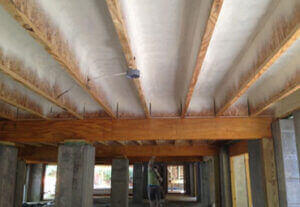Rectangular-shaped holes that penetrate oval or round vents from the crawl space of your home is a common and burdening situation for homeowners, even if you have batt insulation installed. Since batt insulation is unable to create a vapor/air barrier, it cannot contain contaminated, warm, or cold air, from entering your home through the crawl space.
The living space of your home can be infiltrated with mold, earth gases, rodents, and other allergens if your crawl space is not properly sealed. The only material that can achieve a full seal is spray foam insulation. To accomplish an effective thermal barrier from obstructions like ductwork, plumbing, wide/narrow joist spacing, and plumbing, spray foam insulation must be applied between the floor joists of your crawl space.
Due to the use of wire insulation hangers, fiberglass insulation can often be compressed when it is applied. Insulating open web floor trusses properly with fiberglass is nearly impossible since air can move inside the fiberglass. This is because open web floor trusses can generate pathways of air.
Mold, condensation, and a decaying floor system are all generated during the summer, when warm and humid air flows around the fiberglass insulation.
A proper and effective barrier for vapor infiltration between the ground and homes subfloor surface is closed-cell spray foam insulation. Closed-cell spray foam stops any vapor or air from moving into the home’s walls or attic space, eliminating any problems that could be caused by the “stack effect.”
Floor insulation problems are reduced because spray foam completely fills open spaces and voids. Spray foam, unlike fiberglass, fills the open webs of full trusses completely, and creates a complete and uniform thermal barrier on the floor, as it also fills all areas around the wiring and plumbing.
Overcoming several disadvantages that other insulation products can bring to the table, spray foam insulation is the superior product when it comes to insulating your crawl space. A more consistent and uniform thermal barrier that contains air flow/stack effect retarding functions is produced with the application of spray foam.
Crawl space insulation has a much bigger impact on a home’s energy efficiency than most people realize. Unlike a basement, that has both headroom and easy access, a typical crawl space can be difficult to get into.
This is the main reason why crawl space insulation is often overlooked when people are aiming to improve energy efficiency and reduce heating and cooling problems. Insulating a crawl space with spray foam can be beneficial for residential and commercial structures. On top of superlative insulation, spray foam creates an air barrier and moisture barrier for all leakage and infiltration coming in through the structure’s band joists.
Properly Insulating and Sealing Your Crawl Space
Crawlspaces can be insulated two ways: insulating the ceiling for a vented crawlspace or insulating the walls for an unvented crawlspace. Spray foam insulation can be effectively utilized in both ways to help address common problems associated with uninsulated or poorly insulated crawlspaces.
A properly insulated and sealed crawl space is one of the fundamental elements of a comfortable, healthy home. Crawl spaces have long been insulated with fiberglass batt insulation, but modern building science reveals the downsides of that practice. Ideally, crawl spaces should prevent air from infiltrating a home to reduce drafts and improve air quality. Spray foam insulation can provide a more uniform, consistent thermal barrier as well as provide an air and moisture barrier.
When you are ready to make the “foam” call, remember AICSis the place to contact. Visit our website at www.aicsnj.com or email us at aicsnj@gmail.com .







